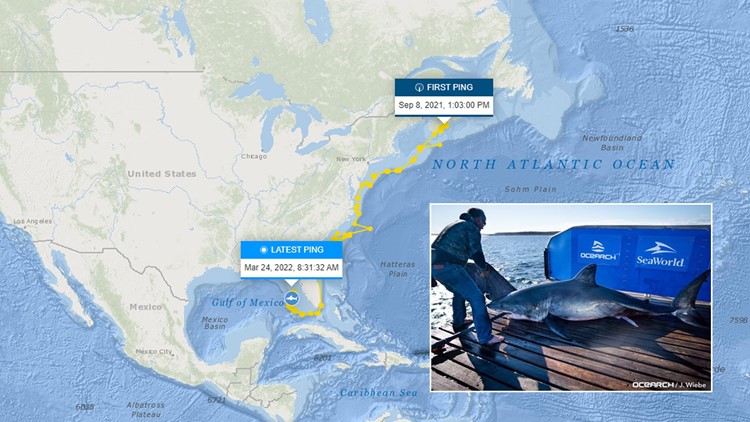FLORIDA, USA — A more than 12-foot-long great white shark is spending spring break off Florida's Gulf Coast, according to data from research group OCEARCH.
Scot is an adult male great white shark that is 12.3 feet long and weighs about 1,644 pounds. His tracker last pinged around 8:30 a.m. Thursday and showed the marine animal was off the Gulf Coast within the West Florida Escarpment.
But you don't need to worry, because he's nowhere near land. He's traveled about 3,910 miles over the last 118 days.
Scot is an adult white shark sampled off West Ironbound Island in Nova Scotia, Canada. He is the 74th white shark tagged, sampled and released by the organization in the Northwest Atlantic Ocean, according to OCEARCH's website. OCEARCH says Scot was the first white shark sampled during Expedition Nova Scotia 2021.
"He was named by our partners at SeaWorld, who have supported wildlife rescue rehabilitation and conservation efforts, and vital ocean health initiatives like OCEARCH for decades," the organization said on its website.
"He was named Scot after the people of Nova Scotia, who have always been so welcoming and committed to the science and health of our oceans," the site continued.
Scot's visit to the Sunshine State follows a visit from Sable, an 11-foot-long great white shark. She pinged off the South Florida coast in February.
Sharks that normally call the East Coast and Canadian coastline home during the summer months travel southward into warmer water during the cooler months, sometimes making Florida their wintertime destination.
You can track Scot and other sharks and marine animals here.
While shark bites are rare, AdventHealth has tips for making sure you stay safe in the water:
Practice shark-safe swimming habits
- Swim in groups. Sharks are more likely to attack someone who’s alone.
- Stay close to shore. It’s harder to get help if you’re bitten in deeper water.
- Don’t enter the water with shiny jewelry or an open wound.
- Avoid swimming at dawn or dusk.
Look for signs of sharks
When it comes to shark attacks, not all beaches are created equal. Taking a moment to assess the beach can lower your risk. Here’s what to look for:
- Murky water. If sharks can’t see clearly, they are more likely to mistake a person for prey.
- Bait fish. Avoid beaches with fishermen. And look for signs of bait fish, including jumping fish and diving seabirds.
What if you see a shark?
First, keep an eye on it but leave the water quickly. This seems pretty obvious, but sometimes surfers don’t leave the water when they should because they’re used to seeing sharks.
You should only hit a shark if you’re attacked, ideally on the nose. Your response should be vigorous — sharks respect size and power, according to the International Shark Attack File.
Remember how rare shark bites are
Shark attacks are frightening, and it can be hard to calmly compare their likelihood to more common risks. But reminding yourself how incredibly rare shark bites are can give you another reason to feel less anxious about visiting the beach.
The International Wildlife Museum says your odds of being bitten by a shark are about 1 in 4 million.
Think about your real risks
The most life-threatening risk in the water isn’t sharks — it’s the water itself.
From 2004 to 2013, there were eight shark attack fatalities in the United States. In that same span, at least 361 people died in rip currents, which are powerful currents of water flowing away from shore.
If you’re caught in one of these currents, try to remain calm and don’t fight it. Swim along the shoreline. And be sure to swim only at a beach protected by lifeguards.



